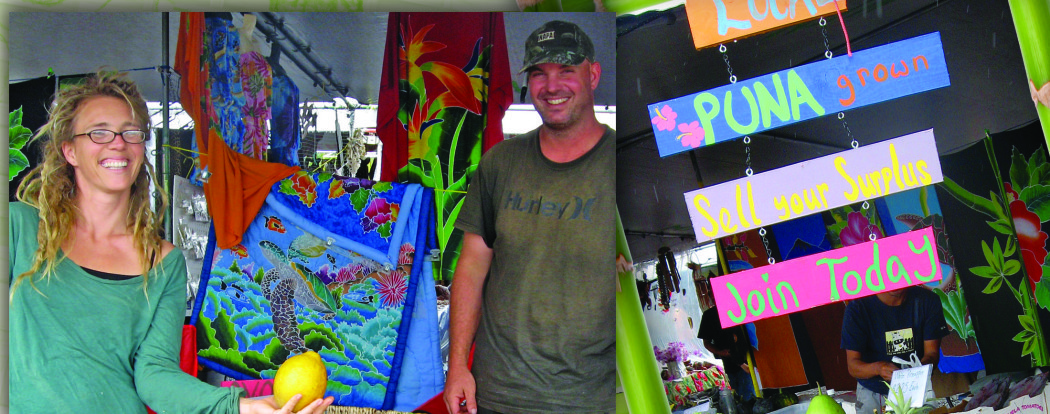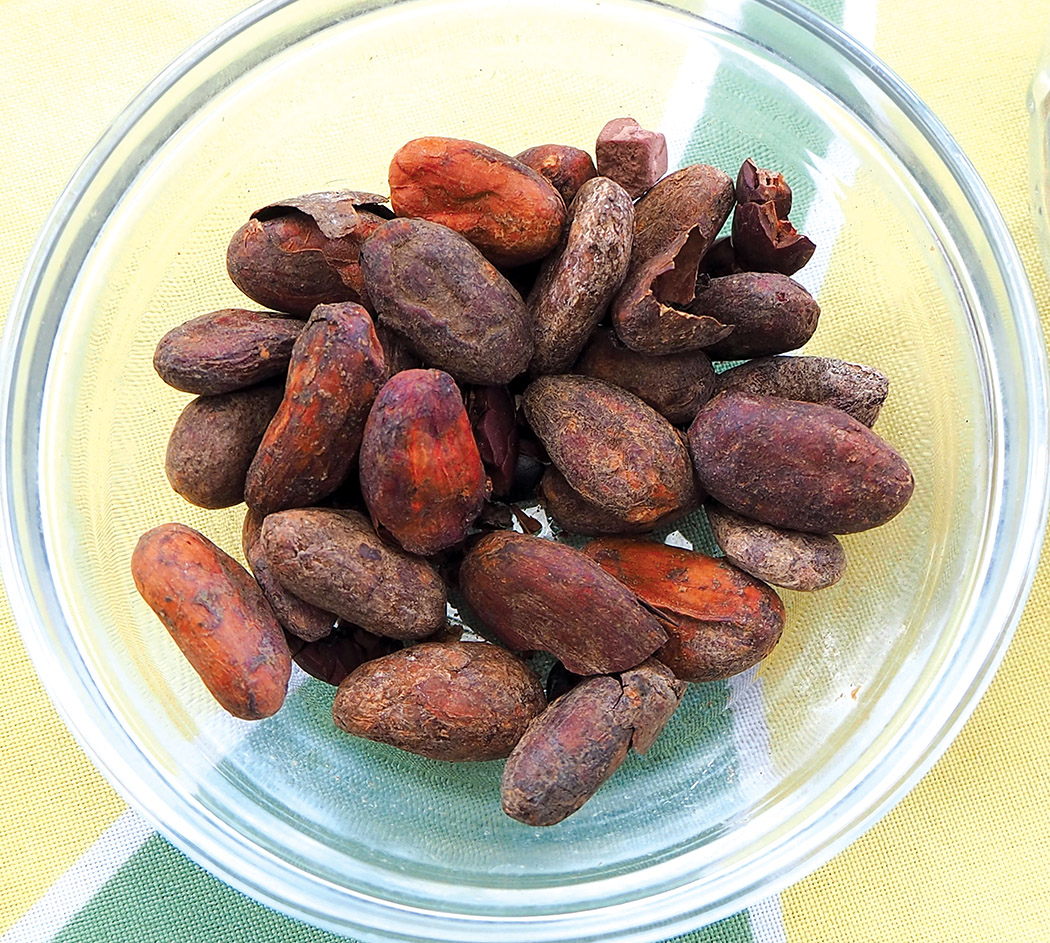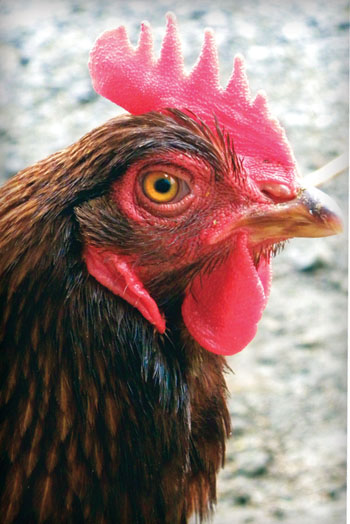
Joy of Chickens: Big Islanders Are Discovering a New Use for Their Back Yards
 By Alan D. McNarie
By Alan D. McNarie
I think a lot of people don’t think that chickens have brains,” muses Jeannette Baysa, co-owner of the Hilo Coffee Mill. “But I think they do. We train them. They know their names. They come when they’re called, even without food.”
Some 140 chickens roam the Mill’s 24-acre grounds near Mountain View, and they’re definitely more than just farm animals. “We don’t raise them for food. We raise them for the eggs and other benefits that they give,” says Baysa. “They’re great with kids.”
Ancient Polynesians brought chickens, or moa, with them when they colonized the islands; for generations, some locals have raised gamecocks, even though cockfighting is illegal here. But lately, more and more rural residential neighborhoods seem to be sprouting chicken coops in their back yards: not the little individual triangular huts that shelter game cocks, but coops for laying hens.
It seems, at first glance, to be part of a nation-wide trend: chicken chic. “Keeping a flock of backyard chickens has gone from being homey to being ‘oh-so-stylishly vogue,’” crowed a recent cover story in Rodale’s Organic Gardening magazine, which featured a full-page photo of a designer coop with red-striped wallpaper, a wrought-iron, chicken-feed holder and a framed giclee poster on the wall. The magazine’s center spread features a gallery of exotic and/or weird-looking breeds.
Here in Hawai‘i, the backyard chicken phenomenon seems to be less about gentleman-farm trendiness and more about sustainability. The island’s last commercial chicken farm closed about two years ago and people are taking on the job themselves.
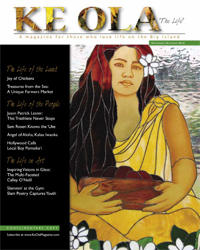
“Ever since the big chicken farm went out in Kawaihae, everyone has been looking for the fresh island egg and they’ve caught on to raising chickens in their back yards,” muses Mike DuPonte, a UH extension agent who helps local farmers (and back-yard beginners) with the birds.
“There are very good economic and ecological reasons why there are no egg farms left on this island and no chickens raised commercially for meat. Number one is feed. There are only a few ways to feed chickens in the tropics and most of those don’t feed very many birds.” maintains Ahualoa chicken grower Ben Discoe.
Ben and his wife, Deb Pun Discoe, originally planned to create a commercial chicken operation on their Ahualoa coffee farm, but cut back to a personal flock of fewer than a dozen birds. They also maintain “Chicken Notes,” an extensive online resource page for local chicken farmers at http://ahualoa.net/chickens.
Information sharing is valuable, especially because there’s a generation gap since grandpa raised chickens.
“Certain ethnic groups have an intact agricultural tradition,” notes Ben Discoe, “but for most of us, it’s about going back and rediscovering, because our grandparents raised chickens, but we didn’t.”
This author is an exception. I grew up on a family farm in Missouri with a flock of 300 hens. It’s sometimes amusing and/or horrifying to watch some newly rural, would-be chicken farmer attempt to solve some simple problem with imagination but lack of knowledge. I remember a well-meaning soul advertising on Freecycle Big Island, the local online recycling club, for a fisherman’s throw net, which she intended to use to catch chickens. “You don’t need a throw net,” I wrote to her. “You need a chicken hook.”
A chicken hook is a pole with a piece of heavy-gauge wire fastened to one end and bent into a shape like a narrow shepherd’s crook. Millions of years of co-evolution with hawks have made chickens extremely wary of threats from the air; they’d probably bolt before a throw net could land. But with a little practice, you can stand back with a chicken hook, slide it along the ground, and hook one of the bird’s feet before it realizes what’s happening. Or you can wait until after dusk when it’s gone to roost, then just pick it up.
That vulnerability after dark is one of the first considerations for a would-be chicken farmer. Chickens need someplace safe to go at night. Originally, they solved the problem by roosting in trees, but many modern breeds are just too heavy for that.
 The website www.backyardchickens.com carries over 450 different coop designs, among other resources. DuPonte suggests a model for a chicken shelter that was invented by a local couple, Liz and Mike Hubble. Called the “Hubble Bubble,” it’s inexpensive and easy to build: 16-by-16-foot square with chicken-wire walls, surmounted by a dome-shaped roof covered with white greenhouse plastic.
The website www.backyardchickens.com carries over 450 different coop designs, among other resources. DuPonte suggests a model for a chicken shelter that was invented by a local couple, Liz and Mike Hubble. Called the “Hubble Bubble,” it’s inexpensive and easy to build: 16-by-16-foot square with chicken-wire walls, surmounted by a dome-shaped roof covered with white greenhouse plastic.
“We’ve been going around the county. We’ve built four or five of them with CTAHR’s (College of Tropical Agriculture and Human Resources) help,” explains Mike Hubble. At their most recent henhouse-raising, on Hawaiian Homelands in Panaewa, about 20 native Hawaiians gathered and got the job done in less than two hours. Materials, Hubble says, cost about $275.
The Hubbles had raised chickens in Idaho before moving to lower Puna in 2007. There they realized a need for a more airy, economical coop suited to the tropics. DuPonte saw their first Bubble, and asked them to draw up plans that others could use. The CTAHR office in Hilo now offers a brochure with instructions for building Hubble Bubbles. Those interested can call DuPonte at 808.981.5199.
A henhouse has its own furniture: raised roosts, feeders and nest boxes. Feeders can be found at any farm supply store; roosts can be improvised out of two-by-two lumber, round poles, bamboo or even tree branches. The Hilo Coffee Mill flock sleeps on guava branches. Nest boxes come in a wide variety of forms. My family built free-standing rows of nests for better access and ventilation: three tiers of wooden nests, each nest 18 by 18 by 18 inches, with a wooden perch in front and a hinged, drop-down board in back so we didn’t have to face the angry end of the chicken when we gathered the eggs. Some hens will defend their nest by pecking. Any box of about those dimensions will do, if it’s elevated, fastened down and lined with straw or dry grass.
The next step, after building the henhouse, is to get the chickens. Sometimes they can be had for free; a neighbor may have a hen who’s gone “broody”—has stopped laying eggs and has settled down to hatch some. Or some may just wander in out of the jungle, if you feed them.
“We usually bring in either eggs or chicks from the mainland,” says DuPonte. “Different feed stores bring them in every once in a while. I’ve seen them in Hilo and Pahoa.”
The state only has one commercial hatchery left: Asagi Hatchery, on O’ahu (www.asagihatchery.com) which normally sells three varieties: White Leghorns (the favorite of commercial farms because they lay uniform white eggs and lots of them, but they’re very lightweight and extremely flighty), Cornish Rock hybrids (heavy, fast-growing white chickens raised mainly for meat) and browns (a mellow breed that lays brown eggs). They deliver to other islands.
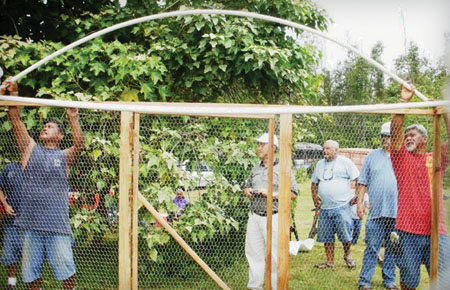
Another possible source of new birds is the Hilo Coffee Mill. “We bring in sexed pullets for people,” says Baysa. She notes that most commercial hatcheries have a minimum order of 25 chicks, but the mill can order a batch and split them among different buyers.
Chicks are designed to start out life literally under the wings of their warm and protective mothers, so their down isn’t a very good insulator. Even in Hawai‘i, they need warmth at the beginning. For starting a backyard-sized flock, says Baysa, a 250-watt, red heat lamp with a reflector collar, available from most hardware stores, will do. There are scores of varieties available: some bred for egg production or for meat, some for egg color (those blue or green eggs seen at farmers’ markets may come from a South American breed called Araucanas), and some for gentleness.
“For us, the Rhode Island Reds are real popular and so are the Araucanas.” says Baysa. “We also bring in the special breeds; if someone wants to have the Buff Orpingtons or Coocoo Morans [which look somewhat like barred Plymouth Rocks with feathers on their feet, and lay deep brown, chocolate-colored eggs] or Black Stars [Black with teal highlights in its feathers; they also lay brown eggs]. We typically won’t bring in any white egg layers. They’re too commercial-looking. When you think of a farm, you think of brown.”
“We’ve got barred Rocks, Buff Orpingtons and Australorps (Australian Orpingtons),” says Ben Discoe. “Buff Orpingtons are kind of like the golden retrievers of chickens. They’re more people friendly. They like to be petted. But they do go broody.”
Egg color, he maintains, has nothing to do with nutrition. For your and their health, what really matters, he maintains, is the chickens’ diet: “Do your best to make sure they have access to fresh green plants. Chickens who can eat grass and plants are many times healthier and have eggs that are far more nutritious.”
Diet is perhaps the biggest challenge in Hawai‘i. Most of the chicken feed on my family’s farm came from our own fields: oats, wheat and corn; we bought mash and whey blocks (the former a brewing byproduct, the latter a by-product of cheese production) for protein and ground oyster shell for calcium (needed to make eggshells.) But Hawai‘i grows almost no grains, its dairy industry is almost as dead as its commercial poultry industry, and it has no commercial oyster beds.
“It’s just crazy to grow feed in Iowa and ship it to Hawai‘i to grow an egg,” maintains Ben Discoe. But even with imported feed, Mike Hubble finds home layers a bargain.
“Feed is about 35 cents a pound. $17 per 50-lb. bag,” he says; a bag, on average, lasts ten days. “We were spending about $1.75 per dozen eggs, and they sell for about $3.50.”
Other local flocks get fed at least partially with local products such as coconut, mac nuts and kitchen scraps; left free to forage, they’ll enrich their diets with bugs and wild grasses. Which brings up another big question: caged layers vs. “free range.” Most commercial egg farms confine their birds to coops; traditional hens come back to the henhouse to roost, lay eggs, and get out of the rain, but spend their days outdoors. Aside from enriched diets, better exercise and less disease, the birds just seem more contented.
Some consider caged layers a cruel way to raise poultry. On the other hand, totally unrestrained chickens can destroy flowerbeds, wipe out a lettuce bed, and leave chicken manure on front porches. One compromise between cages and free-range is a “chicken tractor”: a portable coop which can be moved frequently from place to place, so the back yard gets the benefit of manure fertilizer without being scratched bare.
Sanitation is the final challenge. Some would-be farmers give up the first time they have to shovel the manure out from under the roost. For others, that manure is a benefit: it’s excellent fertilizer. Manure does have to be dispersed or composted to prevent odor and health issues. One partial solution is to let the chickens help with the dispersal. The Hubbles, for instance, pile lawn trimmings inside the coop. The chickens happily scratch around in the cut grass, dispersing the manure in the process.
“By the time they go through it all, there’s no pile up at all…only the normal number of flies and hardly any smell,” reports Mike Hubble.
For chicken-lovers, the clean-up is worth the benefits, which are many: food, fertilizer, pest control (chickens eat many destructive insects)—even companionship.
“They do have personalities,” says Baysa. “We treat them as pets. In fact I have one right now with a broken leg with a cast on it.” ❖
Email Alan McNarie at amcnarie@yahoo.com.
Photos by Devany Vickery-Davidson

